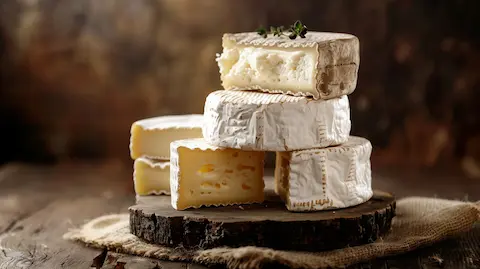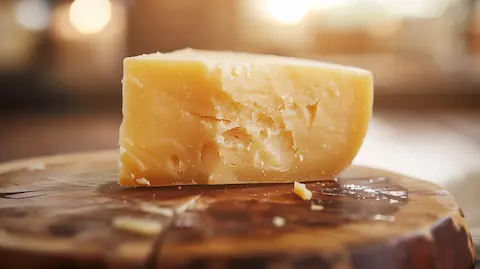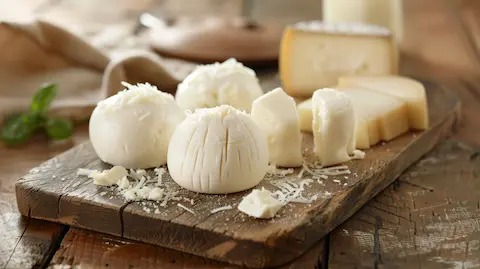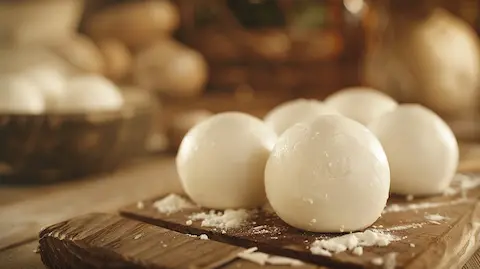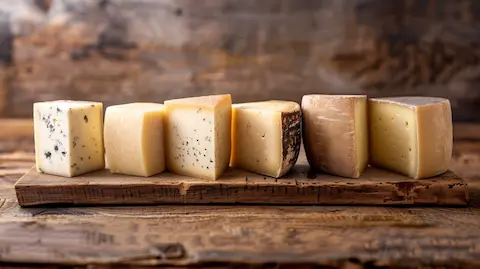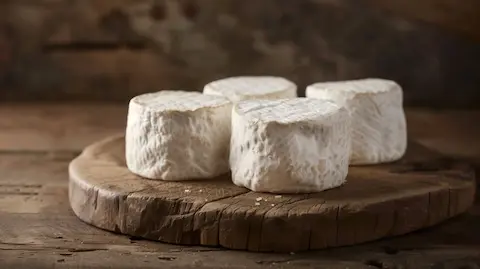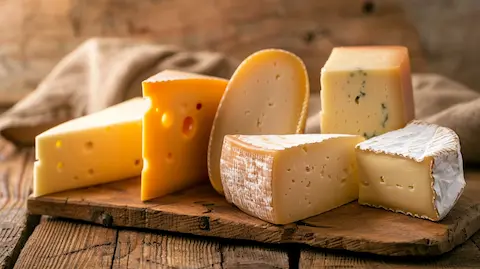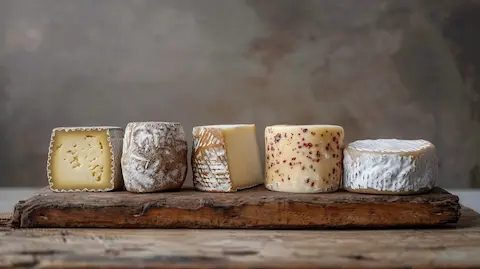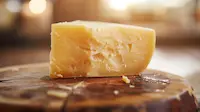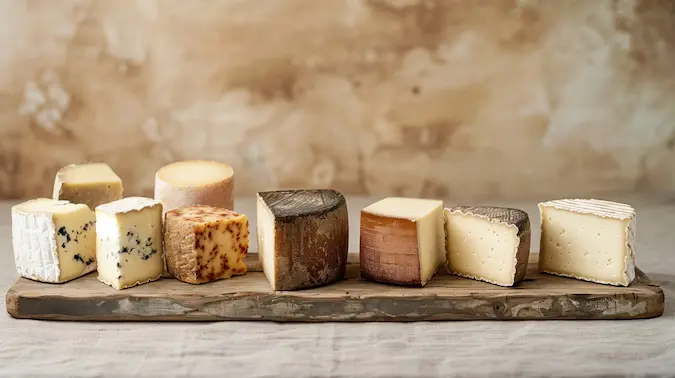Cheese Types: A Comprehensive Overview
The diversity of cheese is vast - with each type offering a distinct set of characteristics that impact its flavor, texture, and culinary use. Cheeses can be broadly categorized based on their firmness, from the velvety softness of a fresh Chevre to the granular hardness of an aged Parmigiano-Reggiano. The aging process, known as affinage, is responsible for developing the depth of flavor and texture in cheeses like Gouda and manchego, with longer aging times resulting in firmer textures and more intense flavors.
Soft cheeses, such as Brie and Camembert, are known for their creamy textures and mild flavors, often with an edible rind that contributes to their unique taste profiles. In contrast, hard cheeses like Cheddar and Pecorino are typically aged for longer periods, resulting in a sharper taste and a texture that can range from firm to crumbly. Blue cheeses, with their striking veins of blue or green mold, offer a bold, piquant flavor that is both sharp and salty, while fresh cheeses like Mozzarella and Feta are celebrated for their mild taste and versatility in dishes from salads to baked goods.
Exploring cheeses from around the world reveals the influence of regional climates, cultures, and techniques. From the smoky notes of a Spanish Idiazabal to the nutty undertones of a Swiss Gruyère, the place of origin leaves an indelible mark on the cheese's identity. Unique varieties such as the squeaky Canadian Poutine cheese curds or the briny Greek Halloumi each tell a story of their local heritage and gastronomic traditions.
Given the extensive variety of cheeses available, a structured approach to understanding their many forms can greatly enhance one's appreciation and selection. To aid in this exploration, we present a categorized list of cheese types, exemplifying the breadth of options available to connoisseurs and casual enthusiasts alike.
| Cheese Category | Characteristics | Popular Varieties |
|---|---|---|
| Soft Cheeses | Creamy, spreadable, mild flavor | Brie, Camembert, Chevre |
| Hard Cheeses | Firm to crumbly, sharp flavor | Cheddar, Parmigiano-Reggiano, Pecorino |
| Blue Cheeses | Blue veining, piquant, salty | Gorgonzola, Stilton, Roquefort |
| Fresh Cheeses | Mild, versatile, moist | Mozzarella, Feta, Ricotta |
| Unique Varieties | Distinctive textures and flavors | Haloumi, Burrata, Poutine curds |
| Global Specialties | Regional flavors and techniques | Idiazabal, Gruyère, Manchego |
This categorization serves as a gateway to understanding the nuances of cheese types and sets the stage for the next topic of discussion: the basics of cheese-making, where we delve into the art and science behind these beloved dairy delights.
The Basics of Cheese-Making
The art of cheese-making has evolved from ancient traditions to become a cornerstone of culinary culture. It starts with the selection of milk, which sets the foundational flavor and richness of the cheese. Coagulation follows, a process where rennet and bacteria are introduced to curdle the milk, forming curds. These curds are then separated from the whey, pressed into shapes, and embark on the journey of aging.
Aging, or affinage, is a transformative phase where cheese develops its distinct taste and texture. For example, a young Cheddar is typically mild and creamy, while its aged counterpart offers a sharper, more complex flavor and a firmer texture. Blue cheeses undergo a unique process where they are pierced to introduce air, fostering the growth of Penicillium mold that imparts a tangy essence and striking blue streaks.
Other steps in cheese-making include salting, washing, brushing, or smoking, each contributing to the cheese's final character. The following stages are integral to crafting cheese:
- Milk Selection: The choice of milk affects the final taste and texture.
- Coagulation: Rennet is added to milk to form curds.
- Curd Treatment: Curds are cut, cooked, or stirred to achieve the desired consistency.
- Pressing: Curds are placed into molds and pressure is applied to shape the cheese and remove excess whey.
- Aging (Affinage): Cheese matures in controlled environments to develop its flavor and texture.
- Finishing: Techniques like brining or smoking are applied to enhance flavor.
Each cheese demands a specific approach to these stages. Parmesan, for instance, is aged for over a year, while Mozzarella is best enjoyed fresh. Appreciating the intricacies of cheese-making enriches our understanding and sets the stage for exploring soft cheeses.
Soft Cheeses: Creamy and Luxurious
Soft cheeses, such as Brie and Camembert, are celebrated for their lush, creamy interiors and delicate rinds. These cheeses, often with a buttery and slightly earthy taste, become runnier as they mature. Their luxurious texture is a result of high moisture content and a brief aging period, which prevents the development of a hard texture. Cheeses like Mascarpone stand out in classic Italian desserts and lend a velvety richness to sauces and soups.
These cheeses are not only versatile in the kitchen but also on the cheeseboard. When paired with the right accompaniments, they can transform a simple dish into an exquisite culinary experience. For example, a sliver of Brie on a crisp apple slice or a dollop of Mascarpone on a warm berry tart can delight the palate. Here are some popular soft cheeses and their ideal pairings:
| Soft Cheese Variety | Description | Ideal Pairings |
|---|---|---|
| Brie | Rich, creamy with a soft, edible rind | Fruit compotes, crusty bread, almonds |
| Camembert | Earthy, buttery, with a bloomy rind | Charcuterie, pears, fig jam |
| Mascarpone | Smooth, thick, mildly sweet | Coffee, berries, dark chocolate |
| Chevre (Goat Cheese) | Tangy, soft, spreadable | Olives, roasted beets, honey |
Understanding the subtle flavors and textures of soft cheeses opens up a world of culinary possibilities. Next, we will explore the robust world of hard cheeses, their aging process, and their indispensable role in cooking.
Hard Cheeses: Sharp and Aged
Hard cheeses, such as Cheddar and Asiago, are renowned for their longevity and intense flavor. The aging process, spanning months to years, dehydrates the cheese, resulting in a dense texture and a taste that ranges from nutty sweetness to a pronounced tang. This maturation not only enhances the flavor but also improves the cheese's ability to be grated, making it a staple for enriching a variety of cooked dishes.
In culinary applications, the bold flavors of hard cheeses shine, particularly in dishes like pasta, risotto, and gratins. Parmesan, with its crumbly texture and savory notes, is a cornerstone of Italian cooking, essential in preparations such as Risotto with Shiitake Mushrooms. Pecorino Romano, another aged cheese, is celebrated not only for its taste but also for its place in history as sustenance for Roman legions.
Some hard cheeses and their uses include:
| Hard Cheese Variety | Description | Typical Uses |
|---|---|---|
| Cheddar | Varies from mild to extra sharp; color ranges from white to deep orange | Used in sandwiches, macaroni cheese, and soups |
| Parmesan | Granular texture, rich in umami | Grated over pasta, stirred into risottos, sprinkled on salads |
| Asiago | Fresh Asiago is smooth and mild; aged is crumbly with a pronounced flavor | Perfect for sandwiches, grating into soups, and melting into sauces |
| Pecorino Romano | Salty and sharp, with a firm texture; sheep's milk cheese | Grated over pasta dishes, incorporated into pesto |
Hard cheeses are not only versatile in the kitchen but also serve as a focal point on a cheese board. Their rich history and diverse flavors are a testament to the mastery of the aging process. Next, we will explore the singular realm of blue cheeses and the role of mold in crafting their distinctive profiles.
Blue Cheeses: Sharp and Salty
Blue cheeses are distinguished by the presence of Penicillium cultures, which impart a sharp and salty flavor profile unique to this variety. These cultures are introduced during the cheese-making process, and the cheese is then pierced to allow air to circulate and promote the growth of the mold. This results in the characteristic blue or green veins that run throughout the cheese, contributing to its robust and tangy taste.
Blue cheese varieties like Gorgonzola, Stilton, and Roquefort are not just known for their bold flavors but also for their creamy to crumbly textures, depending on the duration of aging. These cheeses are often enjoyed on their own, crumbled over salads, or melted into sauces for a depth of flavor. Below are some examples of blue cheeses and their suggested uses:
| Blue Cheese Variety | Texture | Suggested Uses |
|---|---|---|
| Gorgonzola | Creamy to firm | Salads, risottos, pasta dishes |
| Stilton | Semi-soft to crumbly | Paired with port wine, crackers, pears |
| Roquefort | Moist and crumbly | Dressings, steak sauces, figs |
Blue cheeses are a testament to the art of cheese-making, where controlled spoilage is transformed into an exquisite taste experience. With their intense flavor and versatility, they add a gourmet touch to a variety of dishes.
Fresh Cheeses: Mild and Versatile
Fresh cheeses are a testament to simplicity and subtlety in the cheese world. These cheeses are typically not aged, which contributes to their mild flavors and soft, sometimes spreadable, textures. They are characterized by a high moisture content and a pleasantly light taste that makes them adaptable to a broad range of culinary uses. Fresh cheeses such as mozzarella, Feta, and Ricotta can be found starring in salads, as toppings on pizzas, or as key ingredients in desserts.
Mozzarella, known for its delicate flavor and elastic texture, is a staple in Italian cuisine, particularly on pizzas and in Caprese salads. Feta, with its crumbly texture and tangy taste, adds a bold touch to Mediterranean dishes. Ricotta, creamy and mild, is versatile enough to be used in both savory lasagnas and sweet cannolis.
These cheeses also offer nutritional benefits, providing a source of protein and essential nutrients while often being lower in fat than their aged counterparts. Lactose-sensitive individuals may find fresh cheeses easier to digest due to their lower lactose content. Here are some fresh cheese varieties and their common applications:
| Fresh Cheese Variety | Description | Common Applications |
|---|---|---|
| Mozzarella | Mild, elastic | Pizzas, salads, sandwiches |
| Feta | Tangy, crumbly | Salads, pies, spreads |
| Ricotta | Creamy, mild | Lasagna, cannoli, dips |
With their gentle flavors and diverse textures, fresh cheeses are an excellent starting point for those new to the world of cheese and a beloved staple for seasoned aficionados. As we transition from the fresh cheeses, we move on to the exploration of unique cheese varieties that offer distinctive culinary experiences.
Unique Cheese Varieties
Beyond the well-known cheese families lies an assortment of unique varieties, each offering an unexpected sensory adventure. These cheeses defy conventional categorization, presenting distinctive textures, flavors, and culinary roles. For instance, halloumi, a cheese originating from Cyprus, is notable for its ability to retain shape when heated, making it an excellent choice for grilling or frying. On the other hand, Burrata, an Italian cheese, captivates with its creamy center wrapped in a mozzarella-like shell, elevating simple dishes to luxurious treats.
Cheese lovers may also seek out lesser-known treasures such as Crottin de Chavignol, a goat cheese with a bold, nutty flavor that intensifies with age, or explore the squeaky texture of cheese curds, a favorite in Canadian poutine. These unique cheeses not only add diversity to the cheeseboard but also invite culinary experimentation and exploration.
Consider the following unique cheeses and their characteristics:
| Cheese Variety | Origin | Characteristic |
|---|---|---|
| Halloumi | Cyprus | Firm texture, withstands high heat |
| Burrata | Italy | Creamy center with a mozzarella shell |
| Crottin de Chavignol | France | Small, nutty, becomes firmer with age |
| Cheese Curds | Canada | Squeaky texture, used in poutine |
These examples barely scratch the surface of the cheese world's diversity, as each country and region contributes its own specialties to the global cheese tapestry. As we journey from these unique varieties to cheeses from around the world, we further appreciate the cultural stories woven into every wedge and wheel.
Cheeses from Around the World
Cheese varieties from across the globe offer a glimpse into the environmental and cultural influences that shape their creation. From the damp, mold-ripening caves of Roquefort to the Alpine pastures that feed the cows producing rich Gruyère, each locale imparts its signature on its cheeses. The vast compendium of over 1905 cheese types is a testament to this rich diversity. Iconic cheeses like England's crumbly Stilton, Italy's robust Parmesan, and France's velvety Camembert exemplify how a region's climate, flora, and time-honored traditions influence the essence of its cheese.
Consider Pecorino Romano, a testament to ancient Roman culinary heritage, still made in Italy using time-honored techniques. Or Brie, whose creamy heart reveals a complex, buttery profile as it ripens. Each cheese narrates the story of its land, offering a taste of local history and artisanship.
When paired with beverages, these cheeses further accentuate their regional characteristics. A crisp white wine may enhance the delicate flavors of a young goat cheese, while a robust red wine pairs well with the assertive notes of an aged cheddar. Our database provides detailed information on flavor profiles, fat content, and pairing suggestions, aiding enthusiasts in selecting the ideal cheese for any occasion. Below is a snapshot of renowned cheeses and their origins:
| Cheese | Country of Origin | Characteristic |
|---|---|---|
| Stilton | England | Rich, blue-veined |
| Parmesan | Italy | Hard, granular |
| Camembert | France | Soft, creamy |
| Pecorino Romano | Italy | Salty, firm |
| Brie | France | Buttery, soft |
As we explore the extensive selection of global cheeses, we prepare to delve into the complementary art of cheese and wine pairing, where these two elements can elevate a meal into a memorable culinary journey.
Cheese and Wine Pairing
The interplay between cheese and wine is a dance of flavors, where each component can elevate the other, creating a harmonious and sophisticated tasting experience. The rich and varied textures of cheese, paired with the complex notes of wine, can bring out subtle nuances in both. This pairing tradition dates back centuries, with each region developing its own preferred combinations that best reflect the local terroir and gastronomy.
Pairing cheese with wine involves more than just matching flavors; it's about balance. A robust red wine may overpower a delicate soft cheese, while a crisp white could be the perfect counterpoint to its creamy richness. The goal is to achieve a pairing where neither the cheese nor the wine dominates but rather, they complement and enhance each other.
For those new to cheese and wine pairings, starting with classic combinations can provide a foundation upon which to build more adventurous pairings. Our database offers a comprehensive guide, detailing which wines pair best with different types of cheese, from the creamy Brie to the pungent Gorgonzola.
Here are some fundamental pairings to consider:
| Cheese Type | Wine Pairing | Why This Pairing Works |
|---|---|---|
| Soft and Creamy Cheeses (e.g., Brie, Camembert) | Champagne, Chardonnay | The effervescence and acidity cut through the creaminess. |
| Hard and Aged Cheeses (e.g., Cheddar, Parmesan) | Cabernet Sauvignon, Aged Port | The tannins in the wine complement the rich, deep flavors of the cheese. |
| Blue Cheeses (e.g., Gorgonzola, Roquefort) | Sweet Dessert Wines, Sauternes | The sweetness of the wine balances the sharpness of the cheese. |
| Fresh Cheeses (e.g., Mozzarella, Feta) | Pinot Grigio, Sauvignon Blanc | Light and crisp wines refresh the palate alongside the mild cheese. |
As you become more comfortable with these pairings, experiment with contrasting and complementing flavors to discover new favorites. The best pairing is one that pleases your palate.
Beyond Wine: Cheese Pairing Alternatives
While wine is a traditional companion for cheese, a variety of other beverages and foods offer delightful pairing possibilities. Beer, with its spectrum from light lagers to dark stouts, can complement or contrast cheese flavors just as well as wine. A crisp lager might pair beautifully with a fresh mozzarella, while a rich stout could stand up to the boldness of an aged cheddar. Ciders, both still and sparkling, provide a fruity counterpoint to creamy or tangy cheeses.
Non-alcoholic drinks also hold their own in the world of cheese pairings. Sparkling water or iced herbal teas can cleanse the palate between tastings, allowing for a pure appreciation of the cheese's flavor. For a more indulgent experience, try pairing dark chocolate with a creamy blue cheese or fresh berries with a tangy goat cheese.
Nuts and fruits are natural partners for cheese as well. The crunch of almonds or walnuts contrasts with the softness of Brie or Camembert, while the sweetness of dried apricots or figs can balance the saltiness of feta or blue cheese. Consider these pairing alternatives to explore new dimensions of flavor:
- Beer: Match the intensity of the cheese with the beer, pairing light beers with mild cheeses and robust beers with strong-flavored cheeses.
- Cider: Opt for sweet or dry ciders to complement soft, creamy cheeses or sharp, aged varieties.
- Non-Alcoholic Beverages: Use sparkling waters and herbal teas to refresh the palate when tasting rich or pungent cheeses.
- Fruits and Nuts: Pair nuts like almonds and walnuts with soft cheeses, and sweet fruits with salty cheeses for a balanced tasting experience.
These alternatives not only diversify the pairing options but also cater to different preferences and occasions. By exploring beyond wine, you can discover new favorite combinations and appreciate the versatility of cheese in a new light.
Nutritional Aspects of Cheese
Cheese is a treasure trove of essential nutrients, providing proteins, vitamins, and minerals such as calcium, vitamin B12, phosphorus, and zinc, which are crucial for bone health, metabolic functions, and supporting the immune system. Despite its nutritional benefits, cheese is also a source of saturated fats and sodium, necessitating moderation in consumption, especially for those with hypertension or high cholesterol. The calorie content of cheese varies, with fresh varieties typically being less calorie-dense than their aged or processed counterparts.
For individuals with lactose intolerance, certain cheeses, particularly aged ones like Cheddar and Parmesan, contain lower lactose levels and may be more digestible. Goat and sheep milk cheeses are also often more easily digested due to their unique protein structures.
The fermentation process in cheese-making can yield probiotic benefits, as some cheeses contain live bacteria that contribute to digestive health and a balanced gut microbiome. The table below highlights the nutritional profiles of common cheese types:
| Cheese Type | Protein | Calcium | Fat Content | Lactose Content |
|---|---|---|---|---|
| Cheddar (Aged) | High | High | High | Low |
| Mozzarella (Fresh) | Moderate | High | Low to Moderate | Moderate |
| Feta | Good | High | Moderate | Low |
| Parmesan (Aged) | High | Very High | High | Very Low |
Making informed choices about cheese consumption can help integrate this versatile food into a balanced diet. Next, we will offer advice on storing and serving different types of cheese to preserve their quality and flavor.
Cheese Storage and Serving Tips
Proper storage and serving of cheese are critical for preserving its quality and flavor. Cheese should be kept in the refrigerator, ideally in a vegetable drawer where the temperature is consistent and slightly higher. Wrap the cheese in parchment or wax paper followed by a loose layer of plastic wrap to allow it to breathe while maintaining humidity. For serving, cheese reveals its full flavor when brought to room temperature. Remove it from the refrigerator about an hour before serving, depending on the thickness of the piece.
Here are simple guidelines for storing and serving different types of cheese:
| Cheese Type | Storage | Serving |
|---|---|---|
| Soft Cheeses (e.g., Brie, Camembert) | Wrap in parchment paper, store in the warmest part of the fridge | Serve at room temperature to enhance creaminess |
| Hard Cheeses (e.g., Cheddar, Parmesan) | Wrap in wax paper, then loosely in plastic wrap | Let sit out for 1 hour before serving |
| Blue Cheeses (e.g., Gorgonzola, Stilton) | Store in foil to retain moisture | Serve slightly chilled to maintain texture |
| Fresh Cheeses (e.g., Mozzarella, Feta) | Keep in original liquid brine, if possible | Serve chilled or at room temperature, depending on the dish |
By following these tips, you can ensure that your cheese maintains its intended flavor and texture, making every cheese experience as enjoyable as possible. With your cheese properly stored and ready to serve, you're well-prepared to create the perfect cheese board.
Creating the Perfect Cheese Board
Assembling a cheese board is an art form that combines flavors, textures, and visual appeal. Begin by selecting a variety of cheeses, aiming for contrast and balance. Include soft, hard, blue, and fresh cheeses to cater to all tastes. For instance, pair a creamy Brie with a sharp Cheddar, a tangy Blue Stilton, and a mild Mozzarella. Add accompaniments like crackers, slices of baguette, and a mix of fruits such as grapes, figs, and apple slices. Nuts like almonds and walnuts offer a crunchy contrast to the cheeses' creaminess. To round out the board, include sweet elements like honey or fruit preserves, and savory options like olives or cured meats.
Consider these steps to create your cheese board:
- Select a range of cheese types: Choose from soft, hard, blue, and fresh to provide a variety of textures and flavors.
- Add bread and crackers: Offer a selection of crackers and bread for pairing with cheeses.
- Include fruits and nuts: Grapes, figs, apples, almonds, and walnuts complement the cheese flavors.
- Incorporate sweet and savory: Honey, fruit preserves, olives, and cured meats enhance the overall experience.
- Arrange with care: Place items on the board with thought to color and spacing, allowing each cheese to be easily accessed.
With these elements, your cheese board will not only please the palate but also serve as a centerpiece for conversation and enjoyment. As you indulge in the flavors and share the experience, you embark on a journey through the rich tapestry of cheese culture and history.
Cheese in Culinary Creations
Cheese has long been a transformative ingredient in kitchens worldwide. Its versatility allows it to be a key player in a broad span of recipes, from simple snacks to complex, refined dishes. Cheeses of various textures and flavors can be melted into a comforting fondue, layered in casseroles, or used as a finishing touch on a gourmet pizza. The use of cheese in cooking is not just about adding flavor; it also contributes to the dish's texture and mouthfeel.
Take, for example, the role of Mascarpone in Italian cuisine. This soft cheese is integral in creating the rich, creamy layers in tiramisu or adding velvety texture to risottos. Parmesan, on the other hand, is often the final flourish on a plate of pasta, adding a burst of umami and a pleasant bite. Cheeses like Mozzarella are celebrated for their meltability, making them a top choice for topping pizzas and lasagnas.
With a nod to the cheese database, one can find inspiration for incorporating cheese into nightly meals or special occasions. Here are some cheeses and their classic culinary uses:
| Cheese Variety | Classic Culinary Use |
|---|---|
| Mascarpone | Tiramisu, risottos, cheesecakes |
| Parmesan | Pasta dishes, risottos, salads |
| Mozzarella | Pizzas, lasagnas, Caprese salads |
Understanding cheese's role in cooking also includes recognizing its impact when consumed on its own. A late-night cheese snack, for instance, can be a delightful end to the day. Whether it's a slice of sharp Cheddar or a few cubes of Gouda, cheese provides a satisfying and comforting experience, especially during those late-night study sessions or gatherings.
Cheese's historical significance is not to be overlooked. Pecorino Romano, once a staple in the diet of Roman soldiers, now graces modern tables, adding a salty, savory depth to dishes. The evolution of cheese from a basic necessity to a culinary luxury mirrors its journey from simple sustenance to a celebrated component of gastronomy.
The cheese database, with its extensive list of varieties, is a treasure trove for those looking to discover new cheeses and their uses. By exploring the database, one can learn about the flavor profiles, ideal pairings, and historical context of cheeses like the English Stilton or the French Camembert. These details not only inform the choice of cheese but also inspire new ways to incorporate it into cooking.
WhatCheese's Resource
If you are passionate about cheese, our cheese database is envisioned as a comprehensive tool that offers detailed information on a vast selection of cheeses. With the ability to search by name, country of origin, type of milk, or texture, enthusiasts can easily discover and learn about new varieties. The database includes many different types of cheese, ranging from everyday favorites like Cheddar and Parmesan to lesser-known gems such as Crottin de Chavignol.
Whether planning a sophisticated cheese and wine party or seeking the perfect cheese for a risotto with shiitake mushrooms, our resource provides valuable insights. It details the flavor profiles, ideal pairings, and even historical context, such as Pecorino Romano's role in the diet of Roman soldiers. For those late-night cravings, We also suggests cheeses that offer a comforting, satisfying nibble without the need for elaborate preparation.
Here's a quick guide to using the cheese database effectively:
- Search Functionality: Look up cheeses by name, origin, type of milk, or texture.
- Comprehensive Listings: Access information on many cheese varieties.
- Pairing Suggestions: Find ideal cheese and wine pairings for every occasion.
- Culinary Applications: Discover cheeses for specific dishes, from appetizers to desserts.
- Historical Insights: Learn about the origins and traditional uses of various cheeses.
By utilizing our resource, you can not only expand your knowledge but also refine your tasting skills and culinary repertoire.
